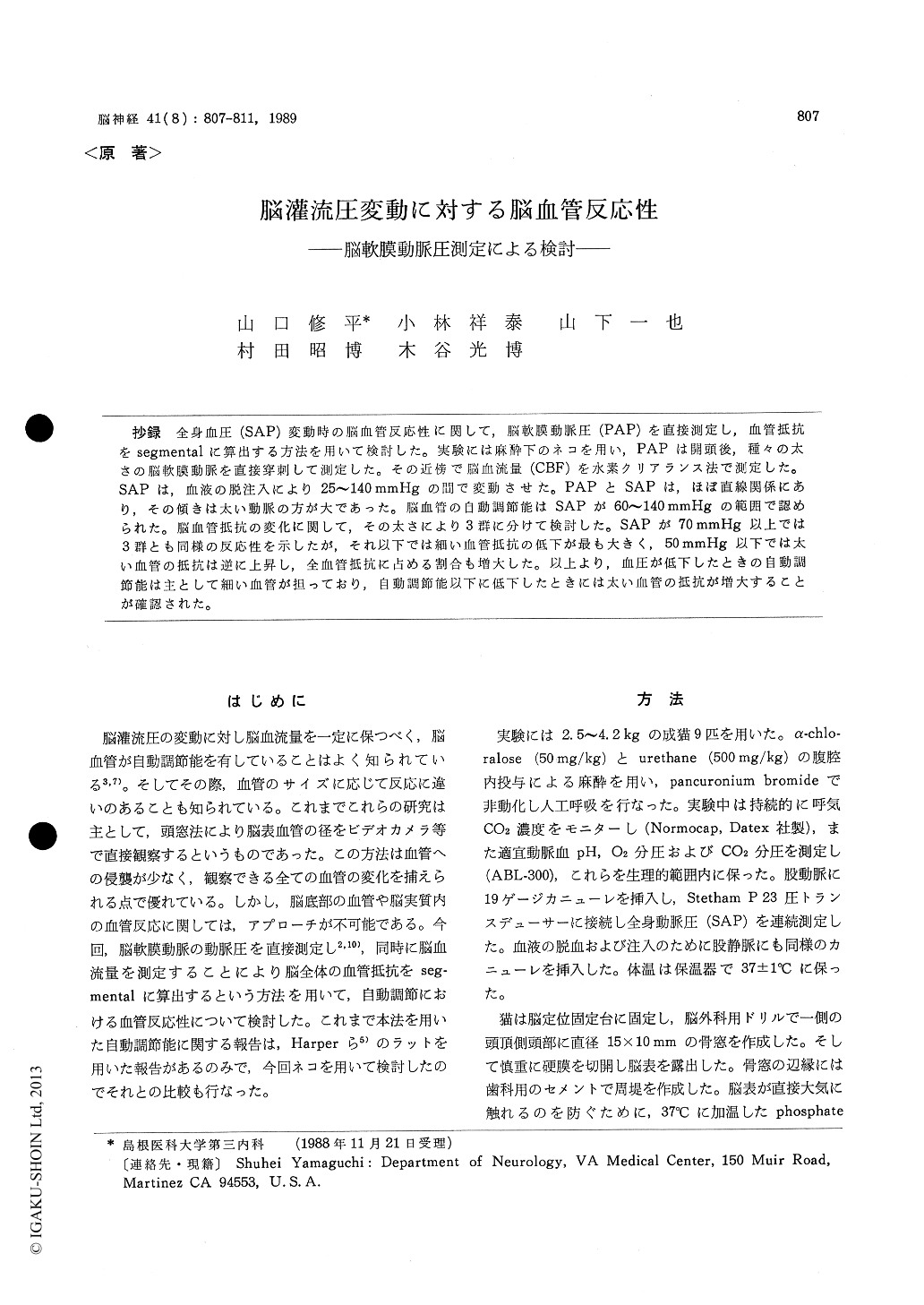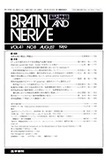Japanese
English
- 有料閲覧
- Abstract 文献概要
- 1ページ目 Look Inside
抄録 全身血圧(SAP)変動時の脳血管反応性に関して,脳軟膜動脈圧(PAP)を直接測定し,血管抵抗をsegmenta1に算出する方法を用いて検討した。実験には麻酔下のネコを用い,PAPは開頭後,種々の太さの脳軟膜動脈を直接穿刺して測定した。その近傍で脳血流量(CBF)を水素クリアランス法で測定した。SAPは,血液の脱注入により25〜140mmHgの間で変動させた。PAPとSAPは,ほぼ直線関係にあり,その傾きは太い動脈の方が大であった。脳血管の自動調節能はSAPが60〜140mmHgの範囲で認められた。脳血管抵抗の変化に関して,その太さにより3群に分けて検討した。SAPが70mmHg以上では3群とも同様の反応性を示したが,それ以下では細い血管抵抗の低下が最も大きく,50mmHg以下では太い血管の抵抗は逆に上昇し,全血管抵抗に占める割合も増大した。以上より,血圧が低下したときの自動調節能は主として細い血管が担っており,自動調節能以下に低下したときには太い血管の抵抗が増大することが確認された。
The responsiveness of cerebral pial a rterie;and arterioles to changes in systemic arterial blood pressure (SAP) was investigated. Using 9 cats anesthetized with chloralose and urethane, direct, simultaneous measurements of pial arterial pressure (PAP) and cerebral blood flow (CBF) were made during changes in SAP. SAP was varied between 25 and 140 mmHg by the hemor-rhage and blood infusion methods. After a partial craniotomy, PAP was measured with a micro-pipette connected to a servo-controlled micropres-sure recording system. Punctured pial arteries were grouped into three types according to their diameters, 1A (291 ± 33 pm), 2A (16 ± 26 pm), and 3A (70±10 Atm). CBF on the exposed cortex was measured with hydrogen clearance method.
The PAPs measured were a linear function of SAP; PAP (1 A)= 0. 73 x SAP ? 6. 6 (r = 0. 96) , PAP (2A) = O. 62 x SAP ? 6. 6 (r = 0. 90) , PAP (3A) = O. 61 x SAP ? 6. 4 (r = 0. 93). This result indicates that PAPs are entirely dependent on SAP and that SAP induced changes in PAPs are less in the smaller pial arteries. Regional CBF remained constant (55±4 ml/100 g/min) between 60 and 140 mmHg of SAP. A significant decrease in CBF was observed below 60 mmHg of SAP.
Cerebrovascular resistances were calculated segmentally using the following formulas ; large vessel resistances (LVR)= (SAP ? PAP (1A))/CBF, middle vessel resistance= (PAP (1 A) ? PAP (3 A))/ CBF, and small vessel resistance= PAP (3 A)/CBF. The changes in LVR, MVR, and SVR were almost identical between 70 and 140 mmHg of SAP. Below 70 mmHg of SAP, SVR showed the greatest decrease in resistance. When SAP was further decreased below 50 mmHg, LVR showed a rapid increase. The ratio of resistance in each sized artery to the total cerebrovascular resistance was calculated as a function of SAP. In the control state, LVR, MVR and SVR was 35.6± 2.8%, 9. 4 ± 2. 9% and 55. 0 ± 2. 8%, respectively. Below 70 mmHg of SAP the ratio of SVR to the total resistance fell rapidly. At 35 mmHg of SAP, SVR occupied only 26. 0± 2. 5% of the total resistance.
The results indicate that small pial arteries play a major role in the response of cerebral vasculature to decreased perfusion pressure when SAP is within a normal range of autoregulation. Below the range of autoregulation, large pial arteries have a large effect on the cerebrovascular resistance. The current study suggests that vas-cular size and systemic blood pressure are critical factors in evaluating the effects of vasoactive agents on cerebral circulation.

Copyright © 1989, Igaku-Shoin Ltd. All rights reserved.


